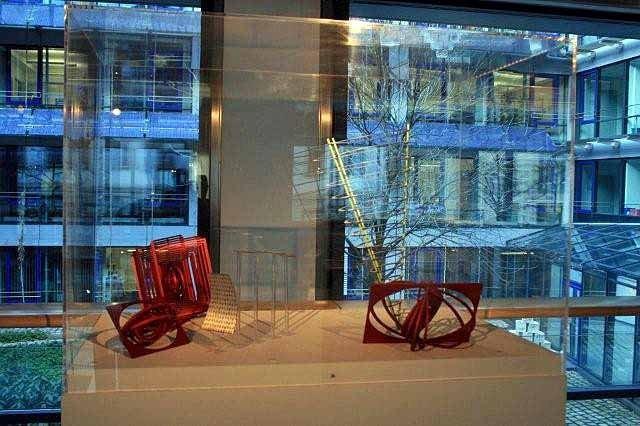
encircle_in all directions
Work show LB Gallery 2009
The recognition and questioning of scientific and social contexts, the philosophical observation of what is possible and what is lived, in the virtual and in our reality, are central themes that Nele Ströbel continually illuminates and puts up for discussion. It raises fundamental questions, reflects on our earthly existence and on paradisiacal dreams, and for all its seriousness never loses its humor. In this exhibition she shows the range of her spatial works and projects from the last ten years. The interplay of hand drawings, digital prints, models and projections visualizes the multi-layered artistic approach to her main theme: the paradigm shift of private and public space. With individual art projects that are interconnected like a mesh, she illustrates the multiple coding of different levels of our communication and knowledge spaces. The intensity of a permanently changing world, the simultaneity of processes that one never sees and perceives in a linear way, can be experienced through their presentation. She plays with boundaries and with fluid transitions. Nele Ströbel defines spaces that can be grasped mathematically, three-dimensionally or as flat volumes without mass, as in building plans. The mental spaces she mirrors in scientific and religious subjects are additionally altered by the thoughts and knowledge of the viewers. The constant exchange with other cultures is important to her.
Sculptor Nele Ströbel creates multi-part works that she develops for specific exhibition venues and places in their respective contexts. Her works consist of many individual objects that come together as installations to form a whole. For example, in her “vogelwolke” (bird cloud), which is inspired by the dynamic geometry of a bird flight formation in the park and extends radially into space; or in “händels locke / eine klangwolke für Halle” (a sound cloud for Halle), which forms a spatial vortex. which is inspired by the expressive scores and the curl of the name patron and the communicative importance of the city. “inside-out_a sugarcube-installation” is what she calls her walk-in airspace, which has the dimensions of an oversized sugar cube and functions as a projection space. The idea arose during a working stay in Port of Spain, the capital of the sugar barons, and thematizes the condition of residential buildings with such thin and fragile walls that the boundary between public and private space seems to dissolve. For the Neubiberg cemetery, she planned a meditation garden with modules made of “SEM terracottas” of burnt earth, whose surfaces are reminiscent of archetypes of single-celled organisms that become visible under a scanning electron microscope. As the gaze and mind become engrossed in the spatial formations, memories of dream plexuses from the REM phase of sleep intensify. Nele Ströbel’s spatial art changes spaces, dynamizes their statics, and allows new connections to emerge, in both a direct and figurative sense. “repairing the world” suggests that the boundaries between man and machine are in dissolution and need to be rethought.
Nina Felicitas Matt M.A.
Exhibition curator
Invalid shortcode
For Baudelaire, the human being is a vast
Essence. Wide-ranging, reaching out, intervening are
also the works of Nele Ströbel, who is not
can be stuffed into a box without further ado.
In her multi-layered work, she boldly combines
Work different media, techniques and materials.
Nele Ströbel does not shy away from the approach
to science and modern technologies
and always ties in experiences from
many trips to other cultures. A starting point
and at the same time the center of this artistic
work is the question of space, of
its disappearance – when place and matter in the
data stream are no longer one unit – after
of its tenacity: it is about researching
of the space-place, as an enlivened, animated
area, not only in art. In the thinking of the
Space lies turns and turns. Nele Ströbels
revolving work, which, as it were, is always new.
and the different directions in which they are
extends, this thinking seems to be in twists
into their art, solutions “on
sample” in the room, the contemplation
release. What happens in their encirclements – in all
directions happens is a kind of navigating in
uncompressible spatial structures.
Thinking the space: how, when, why space becomes
than the Hegelian “indifferent apart”.
something else? The artistic, but also the
architectural construction is in front of this field of tension
to see. In every eviction, in every
Locating is not only the form, but the as
process, not the shaping of the object, but the
information, but the transformation, the design
the essentials. Space never exists a priori. In
researched in all consistency, in all absurdity
Nele Ströbel in her expansive work, which ranges from the
individual tool for the design of a room,
from the open field to the dwelling, from the room installation
to the topography of a magical
Damascus, can jump from the garden to the grotto,
the mystery of space, builds bridges between
Images and knowledge, between past and
Future, between corporeality and optics: your work
as an ongoing configuration of questions to
the space and being in it.
Unabashedly, undauntedly, quite naturally
and yet with light irony Nele Ströbel makes herself
to the repair of the world, moving
sovereignly between the artist’s workshop and
the laboratory of the scientist, between improvisation
and perfectionism, between artistic
venture and priority research, between
traditional craftsmanship
and virtual simulation, with no possibility
excluded, no possibility absolutized
will. Boldly she changes her media and fields,
Works on multiple levels and in between spaces
– between rooms. Cheerfully floating and
without fear of hybrid compositions, of
big questions and very concrete proposals for solutions
it gives meandering versions of space.
Dr. Dorothée Bauerle-Willert, art historian








